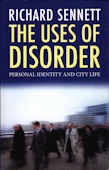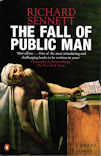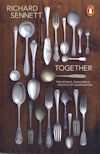Most of us have to work.
But is work just a means to an end?
In trying to make a living, have we lost touch with the idea of making things well?
In this provocative and enlightening book,
Richard Sennett explores the idea of craftsmanship –
the desire to do a job well for its own sake – as a template for living.
Pure competition, he argues, will never produce good work.
Instead, the values of the craftsman,
whether in a Stradivari violin workshop or a modern laboratory,
can enrich our lives and change the way we anchor ourselves in the world around us.
This is a philosophical treatise on the ambiguous status of the
craftsman in society: on the one hand the skilled creator of valuable
artefacts (“Hephaestus”), on the other the creator of
destructive machines (“Pandora”); on the one hand deeply
absorbed and at one with the work and materials, on the other careless
of the potentially hellish results. How to reconcile these aspects?
How to have pride in our work, without becoming obsessive and blind to
its consequences?
A caveat: I read this because I wanted to see if it might illuminate
software development as a craft.
Sennett does mention Linux developers as one example, but his major
examples are more traditional: gold assaying, glass blowing, making
and playing musical instruments. All of these have a much more physical
aspect to them, and I am not yet clear how this ideas translate across
into an abstract medium, except maybe in two cases: education and
not-fit-for-purpose tools.
Sennett has interesting things to say about education: the constant
attempts today to make things “interesting”, to remove the
boredom of repetition, are misguided. To become a craftsman requires
repetition (about 10,000 hours of it, it seems), but that repetition
need not be boring: it should be an engaged repetition, a part
of the process of becoming one with the material. The kind of
engagement is different as different parts of the process become
mastered. That 10,000 hours is a long time: it translates to
10 years of three hours a day practice (for example, mastering a
musical instrument) or seven years of five hours a day (as in a
traditional apprenticeship), or even three years of 10 hours a day
(the training regime for junior doctors). Programming, like all
crafts, is not a spectator sport; it too requires practice. But how to
make it this kind of engaged practice? And how can we
reconcile the time needed to become skilled with the rapid change in
the technologies: that traditional apprenticeship timescale
corresponds to three or four Moore’s law “generations”.
These kind of questions are, unfortunately (for me!) outside the scope
of Sennett’s work.
Sennett makes it clear how craft is a process both of making and of
repair, and that the repair part is where the advances are made. When
things are broken, not working, or the tools are not fit-for-purpose,
then the craftsman has to become yet more engaged in the process, has
to think more about what they are doing, and can make changes,
improvements, advances. Sennett distinguishes two kinds of ways tools
are not fit-for-purpose: they can be inadequate (such as early optical
instruments), so ingenuity is required to overcome their limitations;
or they can be too general purpose (like a flat-bladed screwdriver),
so that how to use them is not obvious. Here I had an “a-ha!”
moment: most software tools are indeed not fit-for-purpose, being both
inadequate (clunky) and general purpose (powerful generic
tools) at the same time. And much software development is
repair (debugging and maintenance), rather than simple building (since
copying is so cheap). So maybe we should not be so critical of our
clunky, difficult-to-use tools: they are helping us advance. Provided
we are suitably reflective when using them, of course.
However, those two cases are only a small part of the overall book.
The rest I found mildly interesting, but not deeply informative. For
my taste, it is too historical (pre Industrial Revolution), with too
little discussion of the present day difficulties of integrating
craftsmanship with mass production and super-human machinery. There is
a only hint of a way forward here, of how to use machines to augment,
rather than replace, people. Personally, I would have liked more on
that, and less history.



